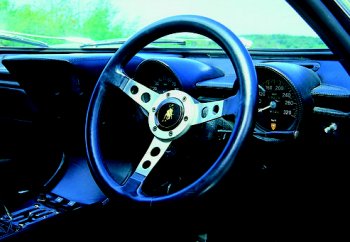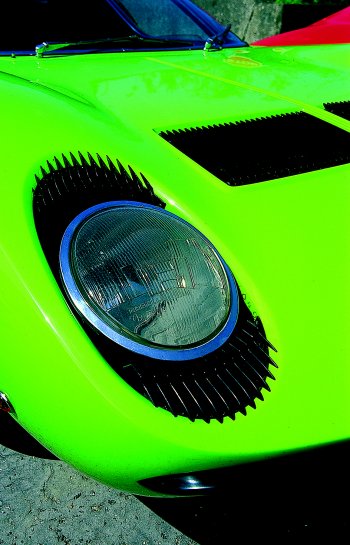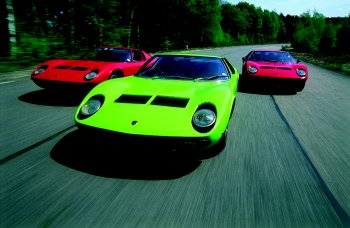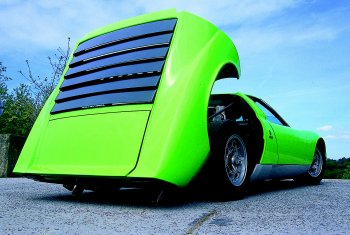|
This feature appears in Auto Italia - Issue 111
- Oct/Nov
2005 |
|
|
Lamborghini
watchers will know that 2005 is the 40th anniversary of the
world’s most beautiful car – the Lamborghini Miura. A normal
celebration is simply not enough for this icon of icons so
the 40th anniversary will span 2005 and 2006, because in
autumn 1965 at the Turin Motor Show, the show-stopper on the
Lamborghini stand was bereft of body. It was just a rolling
chassis with a spectacular mid-mounted transverse V12. Not
only did it not have a bodyshell but no one had even been
commissioned to design one. Nevertheless, the orders flooded
in, so boss Ferruccio Lamborghini handed the design duty to
Bertone. As soon as the Turin Show closed, Bertone got to
work on his new commission. The head of design and
brainchild of the Miura was an astonishingly young
22-year-old Marcello Gandini. After a winter of frantic
work, the March 1966 Geneva Motor Show saw the presentation
of the first real Miura and the immortality of Gandini.
The Miura’s
chassis is a fabricated steel monocoque with hinged front
and rear ends in aluminium, the huge clamshells allowing
unrivalled access to the car’s components. The engine and
transmission unit comprise one single casting which is
mounted transversely between the driver and the rear wheels,
giving a low polar moment of inertia. Centre of gravity is
also low as the gearbox and differential unit nestle behind
the engine rather than underneath it. Suspension all round
is by double wishbone, steering is non-assisted rack and
pinion and brakes are non-servo discs all round – all very
racy, yet with generous luggage capacity and way ahead of
the 1960s opposition.
Miura production
ran from 1966-1973 and saw three distinct model types: P400,
P400S and P400SV. The original 1966 Miura was a rush job and
there was no time for R&D, so each model was an improvement
but some upgrades were introduced mid-series. There were
also a few one-offs like the 1968 Miura Roadster and the
1970 Miura Jota. Ferruccio
Lamborghini permitted test driver Bob Wallace (who wanted
Lamborghini to go racing) to build the Jota – a semi-race
special. This kept Wallace busy and the snorting Jota became
a useful tool for frightening journalists. The original Jota
was totally destroyed in a high-speed crash but Lamborghini
expert Piet Pulford has built a replica of that famous car.
On seeing the original Jota, some Miura owners requested
Jota-esque modifications to their Miuras, calling them SVJs.
Ferruccio was a man on a mission. His feud with Enzo Ferrari
meant that he would not rest until he had built a better car
than his rival. You could justifiably argue that Lamborghini
succeeded with the 350GT, 400GT, and the Islero. With the
Miura there was no doubt: Lamborghini had overwhelmed
Ferrari – the bull gored the horse.
In total, 760
Miuras were built with a great many receiving upgrades. In
their heyday, Miuras had a high attrition rate and, of those
760 cars, fewer than half that number exist today. In the
Miura market, the later the car, the better, with the SV
being the most sought-after. Prices have risen rapidly and
are tipped to join the best from Maranello in the automotive
stratosphere. In the USA, good SVs have already changed
hands for over half a million dollars.
The difference
between the P400 and the ‘S’ is subtle, while the SV is
radically different. That first chassis presented at the
1965 Turin Show was a gorgeous mass of drilled metal. As the
years progressed, so the holes disappeared. The metal also
got thicker to improve the torsional rigidity of the early
cars. Consequently, each model got heavier and required more
power. The SV’s spec includes more power, a stronger
chassis, ventilated discs (introduced mid-S), different
lights, and different front end. New wide-track rear
suspension means a wider rear body, wider wheels and tyres
and more. The rear wishbones and their pick-up points were
redesigned in order to prevent rear wheel steering inputs
which accompanied suspension travel on the pre-’71 cars.
Mid-way through the SV series, the shared oil system for the
engine and transmission was abandoned for split-sump. This
separates the oil systems, prolonging the life of both
engine and gearbox, as well as enabling appropriate oils for
each.
Driving a Miura
is something you don’t forget. Simply walking up to the car
brings on excitement. With the roof at waist level
(42in/1.050m) it feels much like getting into a racing car.
But unlike a racing car, ground clearance is good enough to
cope with real-world driving. As the three Miuras were let
loose on our test track, it reminded me that I must get to
the world’s wildest party at Pamplona for the running of the
bulls.
The P400
With three
beasties ready to run, let’s go in time-order with the
oldest bull first, the P400. This 1967 car is owned by Colin
Gilmore-Merchant and is a low-mileage, right-hand drive,
unrestored example. It was delivered to our test track by
Lamborghini and Ferrari specialist Colin Clarke. As you drop
down into the seat, you immediately inhale that Lamborghini
smell. This car feels soft, warm and homely, like a
favourite old jumper. The sitting position is laughable but
you quickly forget about it. The steering wheel is too far
away and set at such an angle that you could never reach the
top of the wheel without leaning forward. This is
exacerbated by the laid-back seat angle which is essential
if you want your head to clear the low roof. The Miura’s
beautiful proportions mean compromises. The pedals are too
close necessitating a splayed-leg attitude. If they had made
the sitting position more upright and raised the roof; if
they had shifted the pedals (and thereby the front wheels)
further forward, the Miura wouldn’t be the Miura.
Ignition on.
Wait for the fuel pump to settle down. Prime the 12 chokes
with a couple of dabs on the right pedal (no choke is fitted
to any Miura) and the 12 cylinders whoop and fall to a
smooth idle. Keeping the bank of Webers in tune is not the
nightmare that folklore would have you believe. Down the
not-too-heavy clutch pedal, slot the metal-gated lever into
the conventional position for first gear, and away we go.
Power is slightly less but delivery is more linear than with
later Miuras. The P400 does not have that all-or-nothing
feeling each side of 5000rpm.
|
 |
|
In their heyday, Lamborghini Miuras had a high
attrition rate and, of those 760 cars, fewer than
half that number still exist |
|
 |
|
Lamborghini watchers will know that 2005 is the 40th
anniversary of the world’s most
beautiful car – the Miura |
|
|
 |
|
Lamborghini Miura production ran from 1966 to 1973
and saw three distinct model types built: P400,
P400S and P400SV |
|
 |
|
The chassis is a fabricated steel monocoque with
hinged front and rear ends in aluminium, the huge
clamshells allowing for unrivalled
access to the Miura’s
components |
|
|
Despite the low
mileage the rear springs have suffered by supporting 60% of
the P400’s mass for nearly 40 years. Accelerative squat
drags the tail even lower as the nose rises. With this
set-up and a high air-speed, the inside of this Miura would
be a scary place to be. At lower speeds the ride is quiet
and comfy. Roll is noticeable but the suspension element in
the high-profile narrow tyres gives the P400 a fine steering
and ride quality long gone in more modern machines. It’s
great to drive a Miura in its pure original form. That it is
not as fast as the later cars is largely irrelevant as a
Miura is an art form.
The P400S
The middle-aged
bull in our triple test is perfectly matured. This very
green Miura S is now owned by Henry Weitzmann. This is the
famous ‘Twiggy Car’ that we first tested back in issue 18
(Jan/Feb 1998). The icon supermodel in the icon supercar;
something yet to be bettered. Originally a 1968 white P400,
like many Miuras this one has been upgraded. In this case a
factory upgrade in 1970 from P400 to P400S. Then in 1990 the
car was in a garage fire and was returned to the factory for
another rebuild. Henry has owned the car since 1991 and he
emphasises that it is not for sale. Miura ‘S’ upgrades include
chrome window trims, electric windows, a new switch pod in
the roof lining and the ‘S’ badge. Under the skin an ‘S’ has
a stiffer chassis and a more powerful motor. Visually, an ‘S’
is close to its predecessor, the P400, but for straightline
speed an ‘S’ is up there with an SV.
The green car
feels slightly more highly strung than the P400. The ride is
more taut and there is busy-ness from the engine. The extra
20bhp comes at the top end by stretching the red-line to
nearly 8000rpm. Even today, 40 years later, a 4-litre
production engine running at 8000rpm is quite something.
With revs comes power and speed. However, contact with your
passenger is now by SHOUTING. Interior decibels are
surprisingly low for normal town driving or even a legal
motorway jaunt, but if you want to be bad in any Miura you
will need a LOUD VOICE. Heat insulation is good, another
common Miura misconception. Less heat enters the Miura’s
cabin from mechanical components than with a front-engined
car. The main heat source is from the greenhouse effect of
the huge windscreen relative to the small cockpit volume.
Ride is comfy.
Handling is very good – to a point. Push too hard and the
Miura S will complain with roll angles, jaw, squat and dive.
The grippier the tyres, the higher the g and the greater the
jaunty cornering angles. Lift-off oversteer is here in great
quantities, requiring the driver to unwind the steering
should he/she come off the power while cornering hard. Power
delivery is superb. The Miura will pull happily from 1000rpm
round to 8000rpm, although proper power comes in at above
5000rpm.
The P400 SV
Finally, the
young bull – fighting fit and recently back from
international hillclimbs, race circuits and road rallies.
This restoration of this Miura was featured in Auto Italia
issue 106 (May-June 2005). This is a 1970 car totally
rebuilt and upgraded to SV spec. Not an easy task as just
about everything had to be changed. Let’s take my own SV for
a drive. The engine starts with an explosion of revs and
just as quickly settles down to smooth tickover. Lamborghini
engines are much quieter than those from their red rival
just down the road at Maranello.
Minute changes
to the seat angle and steering column make a big improvement
to the sitting position. Despite the gearchange shaft
passing in a straight line through the engine’s sump and
directly into the gearbox, the gearshift on any Miura
requires effort. The clutch is surprisingly light for the
period while the unassisted steering has perfect feel. It is
a little low-geared for parking but the faster you go, the
better it gets. After its restoration, the Miura’s first run
was at Monza and the handling was much better than I could
ever have imagined in a 35-year-old car. With its much wider
rubber, traction and grip are tenacious. Chassis
communication with the driver is enormous, while the
long-travel unassisted brakes do their job well enough. With
their transverse sumps, all Miuras can experience oil surge
in race conditions but not on the road. While an SV is
easily the quickest of the trio, using the SV as a racing
car means cornering at high g with one eye on the oil
pressure gauge. A dry-sump system or an acu-sump would be a
good mod for race-track use.
What makes the
SV so quick is its ability to carry far more speed through a
corner than a P400 or an ‘S’. Power delivery is innocent
enough up to 3000rpm. From 5000-8000 the Miura is truly
spectacular. High-speed Miura nose-lift is dependent on the
aerodynamic angle of attack (or rake). It only happens on
Miuras with tired rear springs. Further jacked-up by its
taller rear tyres, this Miura SV is rock steady at huge
speeds. The top-end power rush is accompanied by a crescendo
of noise. Some SVs were offered with open trumpets, and that
is what we have here. So from 2500rpm you hear that
beautiful induction noise of a bygone era. The SV will reach
60mph in first gear, making it tricky to get off the line
quickly. Second gear will see you banned from driving in
many countries, at 87mph. Third gear is good for 122mph.
Fourth gear, and you pass all the German supercars
restricted to 155mph. In fifth gear, 180mph is all yours.
If
that doesn’t irritate the Health and Safety Police, here is
a statistic. Since 1920, only 14 people have been killed at
the San Fermin Pamplona Bull Run and only a few hundred
injured. Next year’s runs are at 08.00hrs every day from
7th-14th July. See you there.
Test by Roberto Giordanelli / Photography
by Michael Ward
|
|
This feature appears in Auto Italia, Issue 111,
Sep-Oct 2005. Highlights of this month's issue
of the world's leading Italian car magazine, now
on sale, includes a Ferrari four-seater triple
test, the Maserati GranSport on track, story of
the Alfa Romeo 33/3, and the UK launch of the
Fiat Croma. Call
+44 (0) 1858 438817 for back issues and subscriptions. |
|
|
website:
www.auto-italia.co.uk |
|
 |
|
|
![]()
![]()